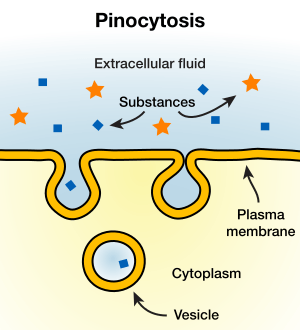Pinocytosis facts for kids
Pinocytosis is a process where a cell takes in liquids and tiny particles from its surroundings. It's often called "cell drinking" because it's how cells absorb fluids. This is a type of endocytosis, which means bringing things into the cell.
When a cell does pinocytosis, its outer membrane folds inward, forming a small pocket. This pocket then pinches off, creating a tiny bubble called a vesicle. This vesicle carries the fluid and particles inside the cell. These vesicles then join with other parts of the cell called lysosomes. Lysosomes contain special chemicals that break down the particles. This whole process needs energy, which comes from a molecule called adenosine triphosphate (ATP). ATP is like the cell's fuel.
Pinocytosis is mainly used to take in fluids from outside the cell. Unlike some other ways cells absorb things, pinocytosis is not picky. It takes in whatever is dissolved in the fluid around the cell.
How Pinocytosis Works
Pinocytosis is a way for cells to absorb nutrients and other important substances that are dissolved in liquids. It's like a cell taking a sip of its environment.
Here's a simple breakdown:
- The cell membrane, which is the outer skin of the cell, creates a small dip or pocket.
- This pocket fills with the fluid and tiny particles from outside the cell.
- The pocket then closes off, forming a small bubble called a vesicle.
- This vesicle moves inside the cell.
- Inside the cell, the vesicle joins with a lysosome. Lysosomes are like the cell's recycling centers.
- The lysosomes break down the contents of the vesicle into smaller pieces.
- The cell can then use these broken-down pieces for energy or building blocks.
Pinocytosis vs. Phagocytosis
You might hear about another process called phagocytosis. Both pinocytosis and phagocytosis are ways cells take things in, but they have a key difference.
- Pinocytosis (cell drinking) takes in liquids and very small, dissolved particles. It's not specific about what it takes in.
- Phagocytosis (cell eating) takes in larger particles, like whole bacteria or cell debris. It's often more specific about what it engulfs. For example, some immune cells use phagocytosis to "eat" germs.
Think of it this way: Pinocytosis is like drinking a smoothie, while phagocytosis is like eating a whole sandwich.
Types of Pinocytosis
There are different ways cells can perform pinocytosis. One type is called "non-specific, adsorptive pinocytosis." In this process, certain proteins on the cell's surface can attract negatively charged substances. This helps the cell take in these specific items more easily.
Cells are constantly performing pinocytosis. It's a vital process for them to get the nutrients and water they need to survive and function properly.
See also
 In Spanish: Pinocitosis para niños
In Spanish: Pinocitosis para niños


